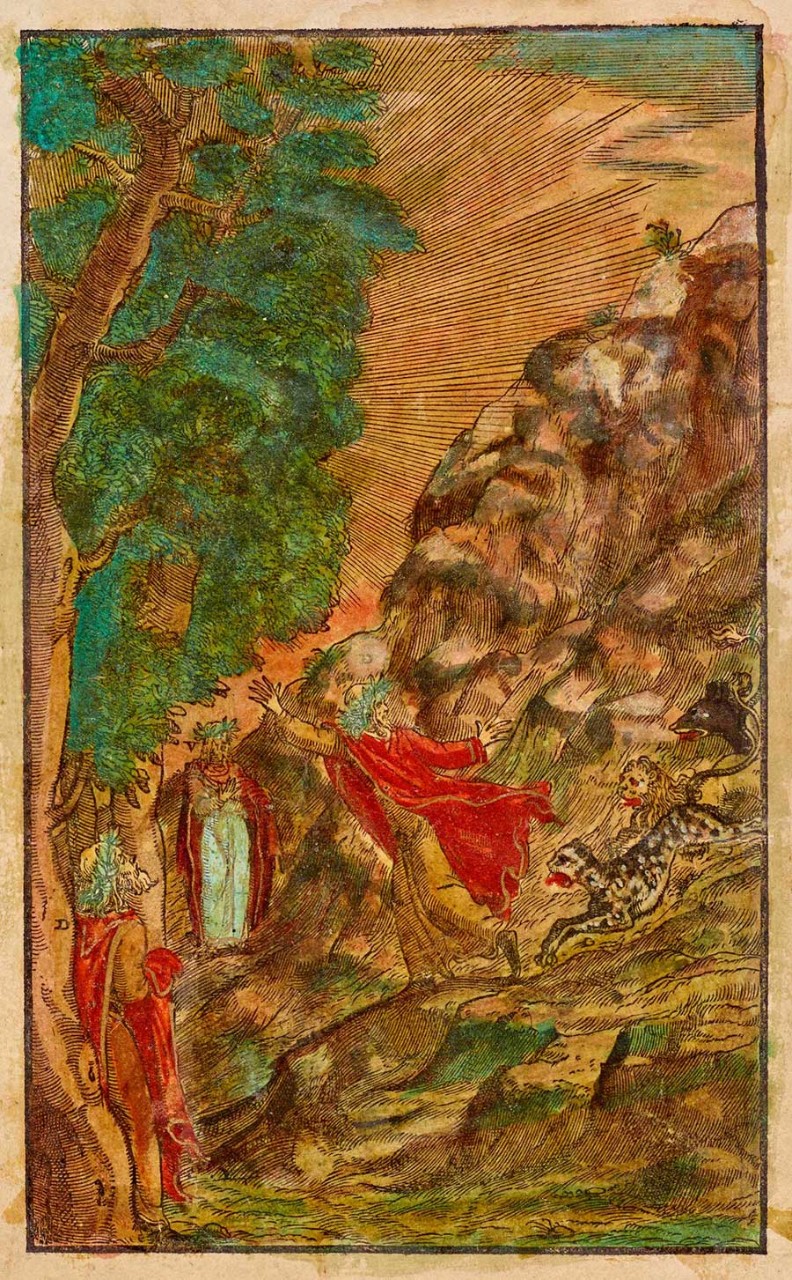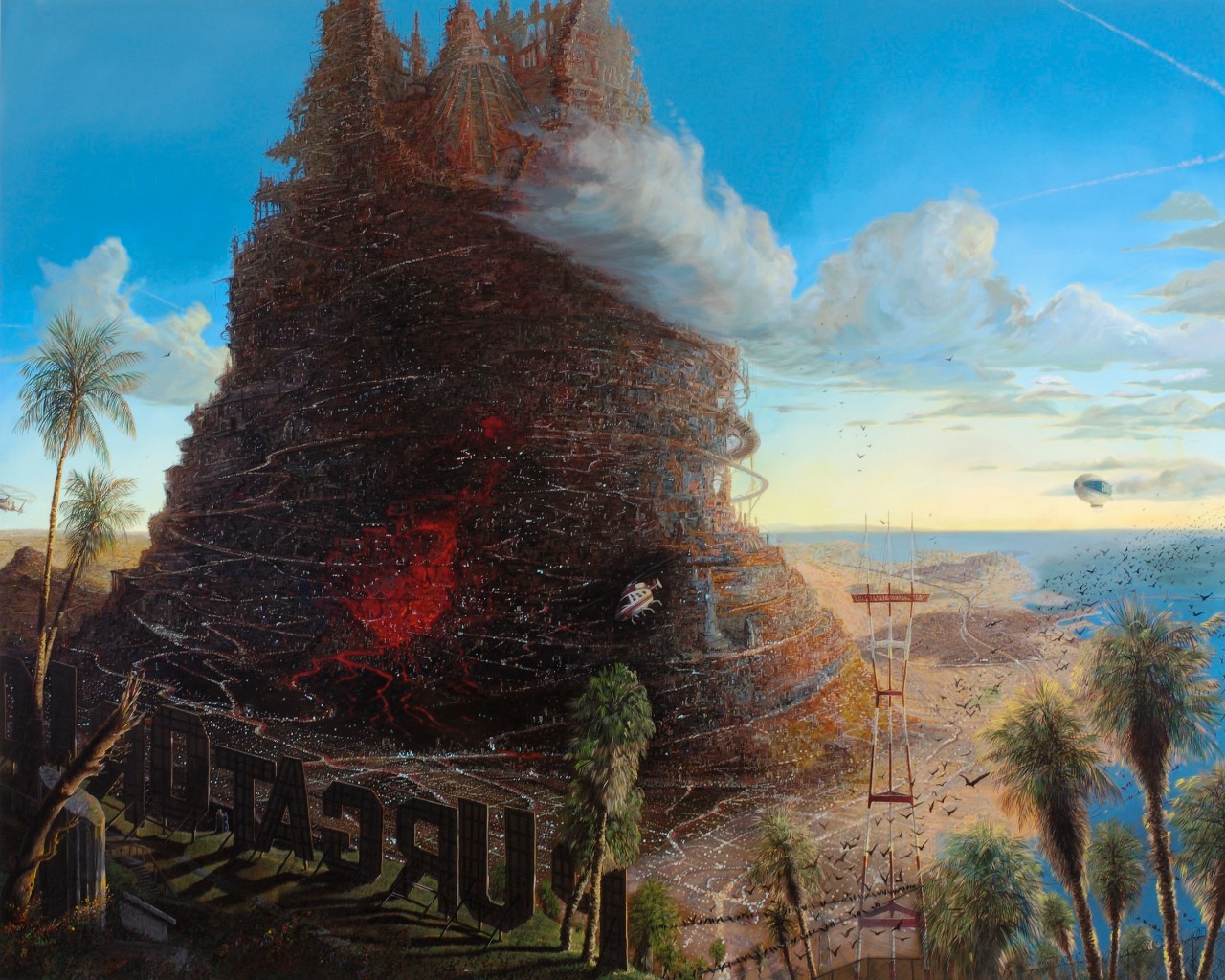The Divine Connector
 Among the centuries-old illustrations discovered in the Rare Book & Manuscript Library, this image depicts a scene from Canto I of "Inferno." (Illustrations from Early Printed Editions of the "Commedia," Digital Dante)
Among the centuries-old illustrations discovered in the Rare Book & Manuscript Library, this image depicts a scene from Canto I of "Inferno." (Illustrations from Early Printed Editions of the "Commedia," Digital Dante)
Digital Dante, one of the world’s foremost platforms showcasing innovative research on Dante and his works, originated as a student project in the early 1990s, more than a decade prior to the rise of digital humanities as a field of scholarly interest. Jennifer Hogan, a former graduate student in the Institute for Learning Technologies at Teachers College, approached Teodolinda Barolini, Lorenzo da Ponte Professor of Italian, with a proposal for a digital platform for Dante-centric inquiry and scholarship, a project that would earn Hogan her Ph.D. in 2000.
“Jen was ahead of her time in creating a digital space for intellectual discourse and community,” said Barolini. “Her project provided the seed for future iterations of Digital Dante.”
Encouraged by persistent feedback from visitors to the site even after the project had stalled, Barolini recognized the value of a platform for scholarly experimentation on Dante that could also help readers at any level deeply engage with The Divine Comedy. In 2014, 20 years after Hogan initially presented the concept to Barolini, Digital Dante was revived in collaboration with the Libraries’ Digital Scholarship unit, with the unit’s Director Mark Newton as the project manager.
“We aimed to create something dynamic and alive for a new generation of researchers that would reflect both current and continuing scholarly work on Dante,” said Barolini.
A pivotal moment in the redevelopment of Digital Dante was the appointment of Columbia’s Western European Humanities Librarian Meredith Levin to the project’s Editorial Board. She entered the conversation as questions of the site’s redesign were surfacing and immediately suggested that Digital Dante turn to the treasures housed in the Rare Book and Manuscript Library for inspiration. With the help of Rare Book Librarian Jane Siegel, the Editorial Board rediscovered three heavily illustrated printed editions of The Divine Comedy from the 15th and 16th centuries. These early volumes were digitized by the Libraries’ Preservation and Digital Conversion Team and their magnificent artwork has since become a trademark of Digital Dante.
Levin now serves as the site’s Managing Editor, while the technical infrastructure is maintained by a team of Libraries staff including Web Designer Ed Madrid and Lead Applications Developer Jack Donovan. Bridging the gap between flipping through a Renaissance incunabulum and clicking through a website, Digital Dante aims to transform the one-dimensionality of print reading into a visual, interactive experience with side-by-side text, translation, commentary, images and multimedia content that coexist beyond traditional boundaries of format and domain.
“The illustrations were an early example of the synergy between Digital Dante and the Libraries,” said Barolini. “Digital Dante’s visual signature resides in its images, and it is emblematic of Meredith’s role and the centrality of the Libraries to the site that she discovered these images in their collections.”
The present site is a visually arresting compilation of global scholarship that transcends traditional notions of form and media: Digital Dante hosts English translations of the Commedia by Henry Wadsworth Longfellow and famed translator Allen Mandelbaum as well as evocative illustrations of the epic based in contemporary America by artist Sandow Birk.
“The beauty of Digital Dante is that it creates intellectual community, keeping Dante scholars connected and in passionate dialogue with one another, and the wonders of the site are sustainable and growing because of the Libraries. It has provided the innovative academic environment in which all of this is possible, not to mention the vision, commitment, and extraordinary leadership of its talented staff.”
– Teodolinda Barolini, Lorenzo da Ponte Professor of Italian
“The work that we’ve shared through Digital Dante is not strictly academic writing by historians and literary scholars,” said Levin. “Our content is more experimental, such as a series of four animated videos designed by a Brazilian architect, Paulo de Tarso Coutinho Viana de Souza, who visualizes Dante’s Hell as a spiral and helps modern readers glimpse inside the mind of Dante and some of his earliest artistic interpreters.”
The digital medium has also allowed the Editorial Board to engage with Dante scholars around the world, fostering an international community of artists, researchers, and students with a shared appreciation for the masterful Italian poet.
“The intellectual community created by Digital Dante extends beyond Columbia to embrace colleagues from other institutions and countries,” said Barolini. “It is a thrilling and intellectually invigorating experience to have the opportunity to create this beautiful platform for dialogue about one of the world’s great global authors and to know that, through the digital realm, our material is reaching a global audience.”
Levin added, “Digital Dante is used by scholars and the general public alike because the format is so much more broadly accessible than most traditional forms of scholarship.”
Curated by the project’s inter-institutional Editorial Board, the selection of multimedia contributions on Digital Dante now includes an audio recording of the Italian text of the Commedia by Professor Francesco Bausi of the Università della Calabria; a study of medieval Jewish poet Immanuel of Rome, interlaced with images of the writer’s surviving manuscripts, by Isabelle Levy, a Fellow of Columbia’s Italian Academy; and Barolini’s own extensive commentary of the Commedia, Commento Baroliniano, which she expects to complete in several years. To further its interest in sustaining truly transatlantic discourse, the entire site will also soon be translated into Italian.
As a testament to its accessibility and ingenuity, Digital Dante is also widely recognized as an ideal tool for teaching and learning, with its engaging multimedia content, rich imagery, and straightforward navigation. The Commento Baroliniano has proven especially effective in preparing students for in-depth discussions of the Commedia in its native language, according to Julie Van Peteghem, Assistant Professor of Italian at Hunter College, City University of New York, and a member of the Digital Dante Editorial Board.
“The combined B.A. and M.A. courses that I teach [on the Commedia] are entirely in Italian, which can be quite overwhelming,” said Van Peteghem. “I found that when I assign the Commento on particularly challenging cantos, students are more confident about the precise content of the canto and better prepared to discuss the issues and questions it raises.”
Victoria Tomasulo, a candidate in the M.A. Teaching Education Program in Italian at Hunter, echoed her professor’s praise of Digital Dante, adding that she plans to use the platform herself in teaching undergraduate and high school-level courses on Italian literature.
“After reading each canto in its original form and its English translation, I read the Commento Baroliniano, which crystallizes its theme and gives the reader food for thought,” said Tomasulo. “The site has been enormously helpful to me in understanding and connecting with Dante.”
Connection - with Dante, with fellow readers, with the robust scholarship shared therein - is central to the mission of Digital Dante and the vision of Barolini and the Editorial Board.
“The beauty of Digital Dante is that it creates intellectual community, keeping Dante scholars connected and in passionate dialogue with one another,” said Barolini. “The wonders of the site are sustainable and growing because of the Libraries. It has provided the innovative academic environment in which all of this is possible, not to mention the vision, commitment, and extraordinary leadership of its talented staff.”
